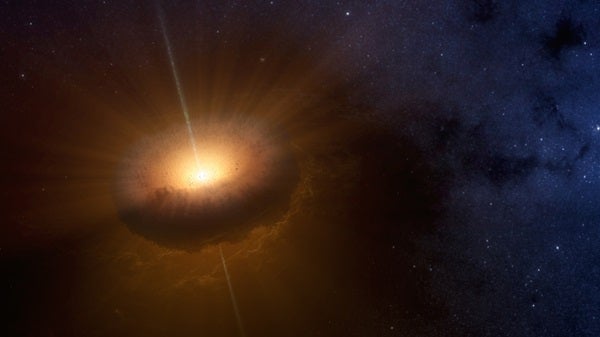NASA’s Chandra X-Ray Observatory back in 2009 detected an unusual object, named CX330, as a source of X-rays as it was surveying the center of the Milky Way galaxy. It was also found to emit optical light as well, but astronomers had not idea what it was. Today, astronomers have a better idea to what this strange object is.
Chris Britt, a postdoctoral researcher at Texas Tech University, and his team determined that CX330 had to be a young star that had been outbursting for many years. In just three years, the star’s brightness had jumped by a few hundred times. Their findings were recently published in the Monthly Notices of the Royal Astronomical Society.
The team was investigating infrared images from NASA’s Wide-field Infrared Survey Explorer (WISE) that were taken around the same area that CX330 was imaged. They found that the object had a lot of warm dust surrounding it, which must have been heated by an outburst.
After comparing the WISE data they were looking at from 2010 and the Spitzer Space Telescope data from 2007, the researchers were able to determine that this star had been outbursting for many years.
Other observatories including the large telescope arrays VVV and OGLE-IV as well as SOAR, Magellan, and Gemini studied the intensity of light emitted from CX330. Combining all of this data, a clearer picture was formed.
“We tried various interpretations for it, and the only one that makes sense is that this rapidly growing young star is forming in the middle of nowhere,” said Britt in a press release.
The star behaves similarly to FU Orionis, another young outbursting star that had an outburst for three months in 1936-1937. CX330 is much more compact; it is hotter and probably more massive than FU Orionis and similar objects. The star, because it is more isolated, can launch faster outflows of material that slam into the dust and gas surrounding it.
A co-author of the study and associate professor at Texas Tech University, Thomas Maccarone said in a press release: “The disk has probably heated to the point where the gas in the disk has become ionized, leading to a rapid increase in how fast the material falls onto the star.”
Objects similar to FU Orionis, which there are about ten of them, are all located in star-forming regions. Strangely enough, CX330 is nearly 1,000 light-years away from the closest star formation region.
“CX330 is both more intense and more isolated than any of these young outbursting objects that we’ve ever seen,” said Joel Green, a co-author and researcher at the Space Telescope Science Institute in Baltimore, in a press release. “This could be the tip of the iceberg — these objects may be everywhere.”
It is thought that maybe all stars go through a similar phase in their lifetimes, but they are so short on cosmological timescales that humans have a hard time observing many of them.
As for how CX330 got so isolated, one idea is that it was actually born in a star-forming region, but got booted to where it is today. Because the star is less than 1 million years old, astronomers are doubtful that it must have formed near its present-day location surrounded by its disk.
Britt said in a press release,“If it had migrated from a star-forming region, it couldn’t get there in its lifetime without stripping its disk away entirely.”
The last time CX330 was observed, in August of 2015, it was still outbursting; astronomers still plan to study the object further with future telescopes that could view it in different wavelengths of light.
These outbursts change the chemical makeup of the star’s disk which could then influence what planets may form. If these outbursts end up being more common than we thought, planetary systems like our own may carry the chemical signatures of the ancient gas disk that was affected by these stellar outbursts.
As CX330 is continually eating its own disk very quickly, astronomers do not expect any planets to form.
“If it’s truly a massive star, its lifetime is short and violent, and I wouldn’t recommend being a planet around it,” Green said in a press release. “You could experience some pretty intense heat for a few centuries.”










